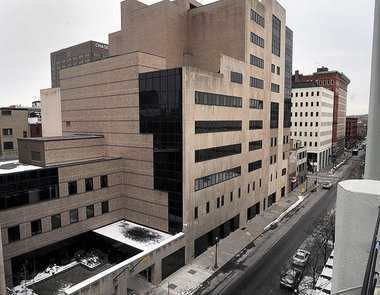From W.W. Rostow to Edward Glaeser to the editorial staff of this very website, academics and social critics alike have lent their voice to the New Urbanism. Cities are objectively better than the burbs, we say, civically more vigorous, economically more efficient, and environmentally cleaner. But an article by architect Sarah William Goldhagen in the latest edition of The New Republic adds nuance to this viewpoint:
While lustered, vertical development is supposed to save its residents from the apathy and alienation of sprawl, Goldhagen points out that the vertically arranged spaces of the modern metropolis often lack common areas upon which cotenants can interact. Thus, poorly designed skyscrapers can theoretically inhibit civic engagement rather than foster it.
Furthermore, while many of us posit urbanism as the antidote to the degrading repetition of strip mall-mania, unimaginative urban structures can similarly prove repetitious and bleak. Goldhagen spotlights a panoply of East Asian structures such as WOHA in Bangkok and a residential development in Hangzhou, China as having solved these problems, at least partially.
Those interested in the architectural nitty-gritty of community-friendly skyscrapers should follow the link above. Those interested in the design solutions to bland apartment-block repetition should do so as well.
The policymakers, however, those who do not hold the reins of the construction process, are in a tighter spot than Goldhagen’s architects, as they must attempt to avoid degrading architecture indirectly through legislation. Thus, those interested in the policy suggestions that arise from Goldhagen’s concerns should read on.
The most valuable tools in the policymaker’s potential toolbox are zoning mandates. In Boston, Mayor Thomas Menino infamously required the architects of the skyscraper, 111 Huntington Avenue, to modify the original design so that the building no longer had a flat top, and he has taken an active role in creating interesting structures ever since. Some say this smacks of big government, but if it keeps my city liveable and aesthetically pleasant, I can tolerate it. Free development is not necessarily a panacea; the unregulated, blockish stretches of central Syracuse, for instance, have become so degraded that a local pundit suggested last month razing several gray, drab downtown blocks. The classical, Lockean justification for private property ownership is based on the assumption that the individual adds value in some way to the land. The most efficient manner to add this value would be to ensure that a city is populated by Goldhagen’s architects, but as this is rarely possible, the legislator has become our stopgap. I have attached images of the section of Syracuse suggested for demolition by a local pundit, and a section of Boston replete with the relatively new 111 Huntington Avenue skyscraper. I hope these images illuminate the choice we have in regard to urban policy: we can allow our downtowns to become degraded places, scary enough to push people back to the suburbs, or we can allow, perhaps force urban construction to approach its Lockean climax, creating landscapes valuable not only to the residents and workers within a building’s walls, but to all urban residents who desire surroundings that are not bleak and repetitious, but vibrant and varied.

A more suitable urban landscape; this building would have been a box without the interference of the city
